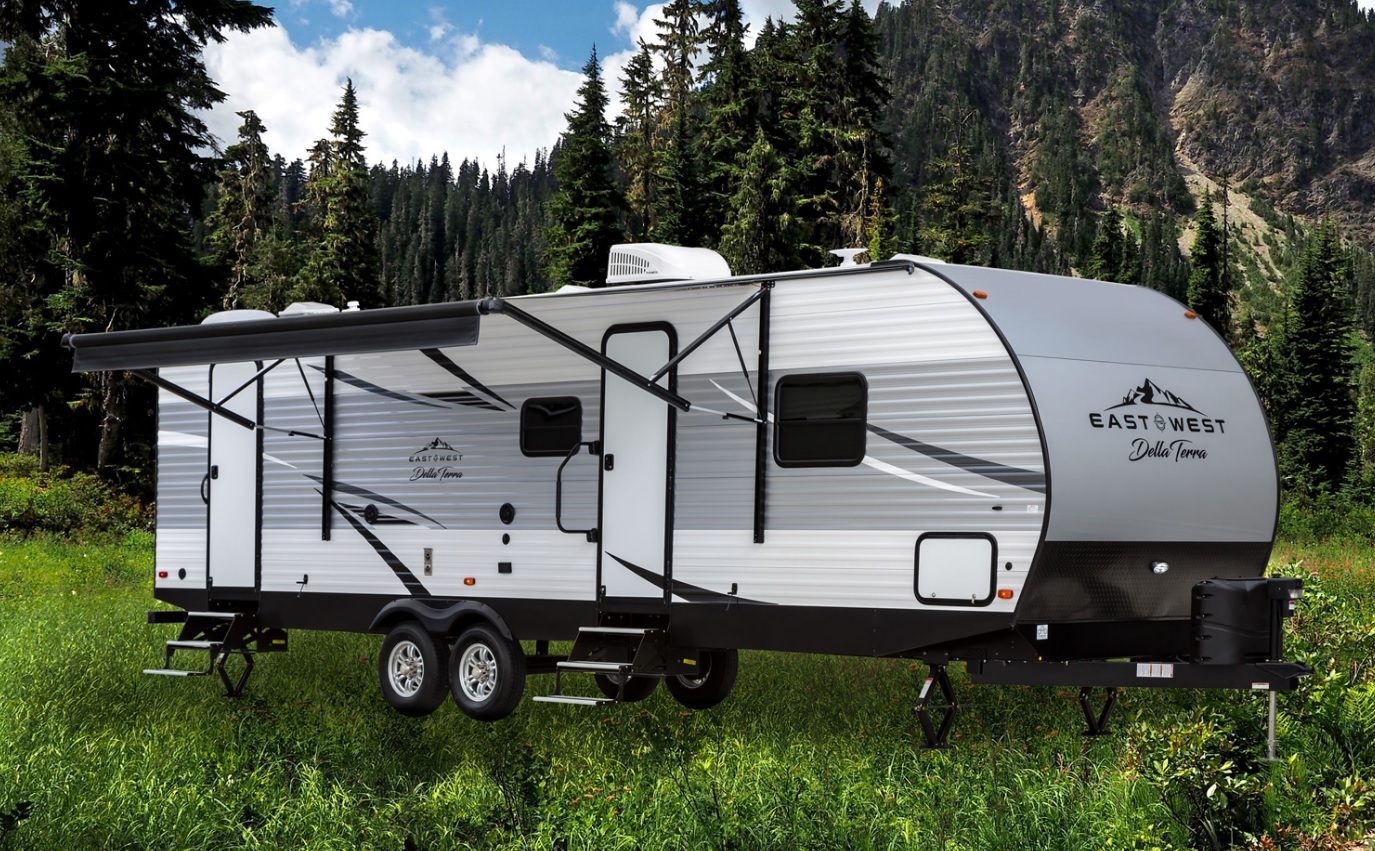Bunkhouse campers and Bunkhouse travel trailers are excellent options for families and groups who love camping together. When you are looking to invest in one of these, two important factors to consider are the storage space and sleeping capacity. Here is a general guide for what to consider when determining the right bunkhouse camper or travel trailer for you.
Interior Cabinets, Cupboards, and Under-Bed Storage in a Bunkhouse Travel Trailer
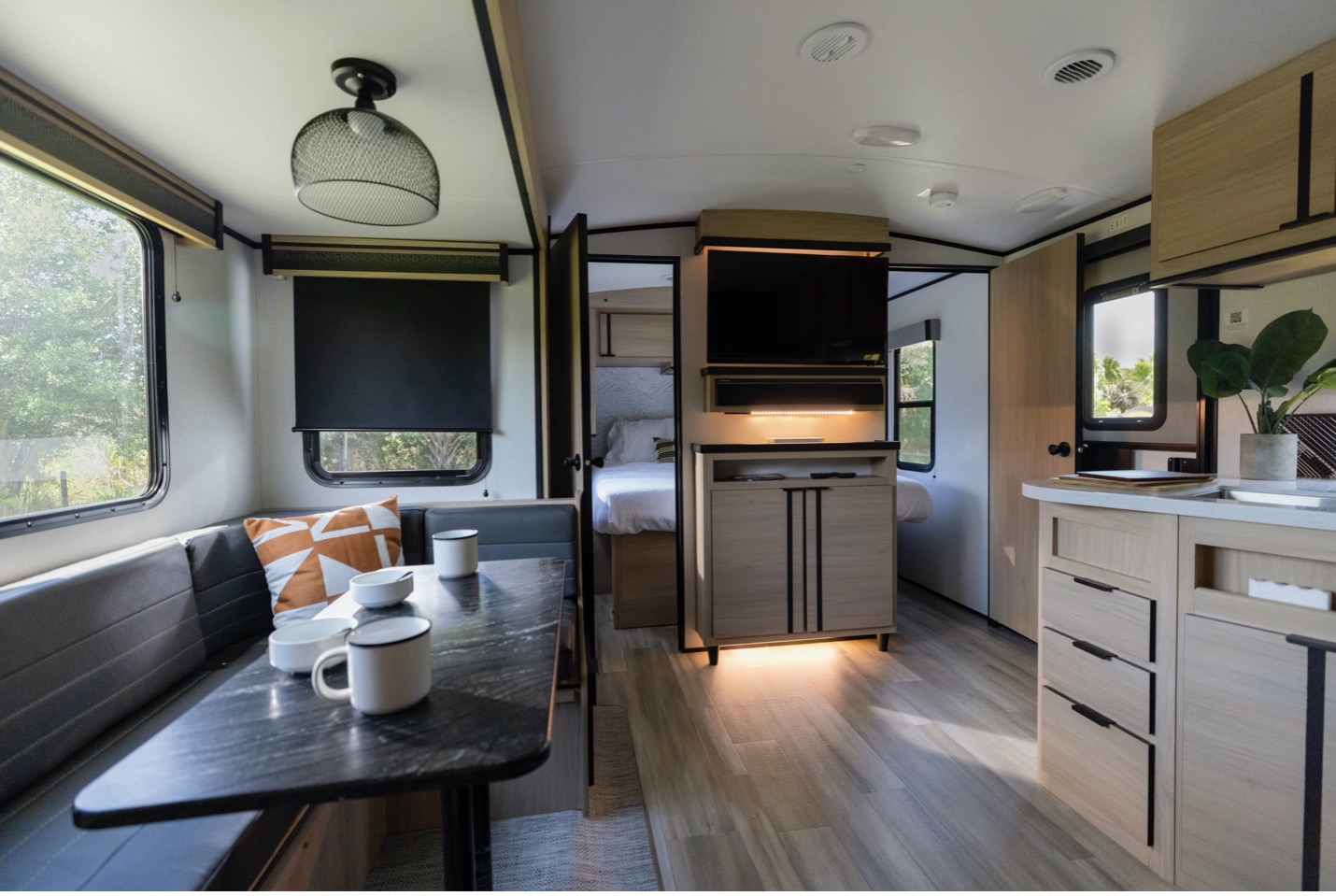
Interior storage solutions like cabinets, cupboards, and under-bed compartments are vital components in a bunkhouse travel trailer, offering organized spaces to store various essentials, from clothing to kitchen supplies. Here’s a closer look at each of these storage options:
Interior Cabinets and Cupboards
Kitchen Cabinets:
Upper Cabinets: Utilized for storing lightweight items like dishes, cups, and food items.
Lower Cabinets: Ideal for heavier items such as pots, pans, and small appliances.
Pantry: Depending on the layout, you might have a dedicated pantry area for storing dry and canned goods.
Bathroom Cabinets:
Medicine Cabinet: Typically mounted on the wall, it's a great place to store medicines, toiletries, and other small items.
Under-Sink Cabinet: Utilized for storing cleaning supplies or toiletries.
Living Area Cabinets:
Entertainment Center: Cabinets around the entertainment center can house DVDs, games, and electronics.
Overhead Cabinets: These can store books, board games, and other leisure materials.
Under-Bed Storage
Master Bedroom:
Storage Bins: Under the bed, you can have storage bins for clothing or bedding.
Safe Box: A hidden compartment for valuables can sometimes be found under the bed.
Bunk Beds:
Drawers: Under-bunk drawers can provide children with space for personal belongings.
Built-in Shelves: In some designs, built-in shelves might be incorporated to utilize the space under the bunk bed efficiently.
Tips for Maximizing Storage Space

Use Multi-Functional Furniture: Furniture that doubles as storage, like a bed with built-in drawers, can save space.
Organize Wisely: Use organizers inside cabinets and cupboards to make the most of the space available.
Vertical Storage: Utilize vertical space by installing shelves or racks in cabinets and cupboards.
Seasonal Storage: Use under-bed storage to store seasonal items that are not in use year-round.
Customization: Consider customizing the storage spaces to fit your specific needs better.
Safety Considerations
Weight Distribution: Ensure that the weight is evenly distributed to prevent any imbalance which might affect the stability of the trailer.
Securing Items: Secure loose items properly to prevent them from shifting or falling during travel.
Flammable Items: Store flammable items carefully, away from potential sources of ignition.
When considering a bunkhouse travel trailer, scrutinizing the interior cabinets, cupboards, and under-bed storage is vital to ensure that it meets your requirements and facilitates a comfortable and organized camping experience.
Pass Through Storage and Basement Storage in a Travel Trailer Bunkhouse Camper
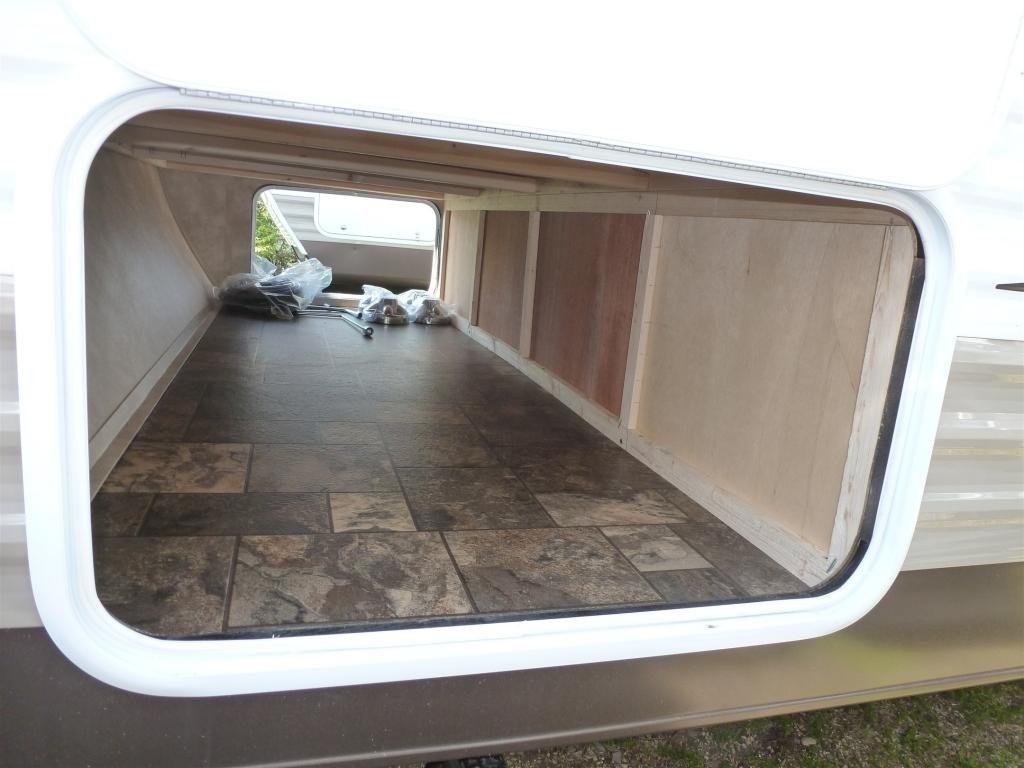
In bunkhouse campers or travel trailers, pass-through storage and basement storage are incredibly important, offering extra space to store camping gear, utilities, and other necessities. Here's how these storage spaces are generally designed and how they can be utilized:
Pass-Through Storage
This type of storage is typically found in the front section of the trailer, running from one side to the other, offering convenient access from either side of the trailer.
Design and Accessibility:
Wide Access: Designed with wide doors on either side of the trailer, facilitating easy access to stored items.
Lighting: Often equipped with lighting to help find items even in low light conditions.
Weatherproof: Usually sealed to prevent water ingress and protect your belongings from the elements.
Usage:
Camping Gear: Ideal for storing larger camping gear like chairs, tables, and grills.
Tools and Utilities: Can store necessary tools, leveling blocks, and utility hoses.
Recreational Items: Perfect for storing recreational items like fishing rods, bikes, or inflatable kayaks.
Organizational Tips:
Shelving Units: Install shelving units or storage bins to organize items better.
Hooks and Hangers: Use hooks and hangers for storing tools or other equipment efficiently.
Basement Storage
This type of storage is found underneath the living space of the trailer, offering a significant amount of storage area for various items.
Design and Accessibility:
Spacious: Generally spacious, allowing for the storage of larger items.
Enclosed Area: Offers an enclosed area to protect your belongings from the weather and road debris.
Easy Access: Usually accessible through large doors on the sides of the trailer.
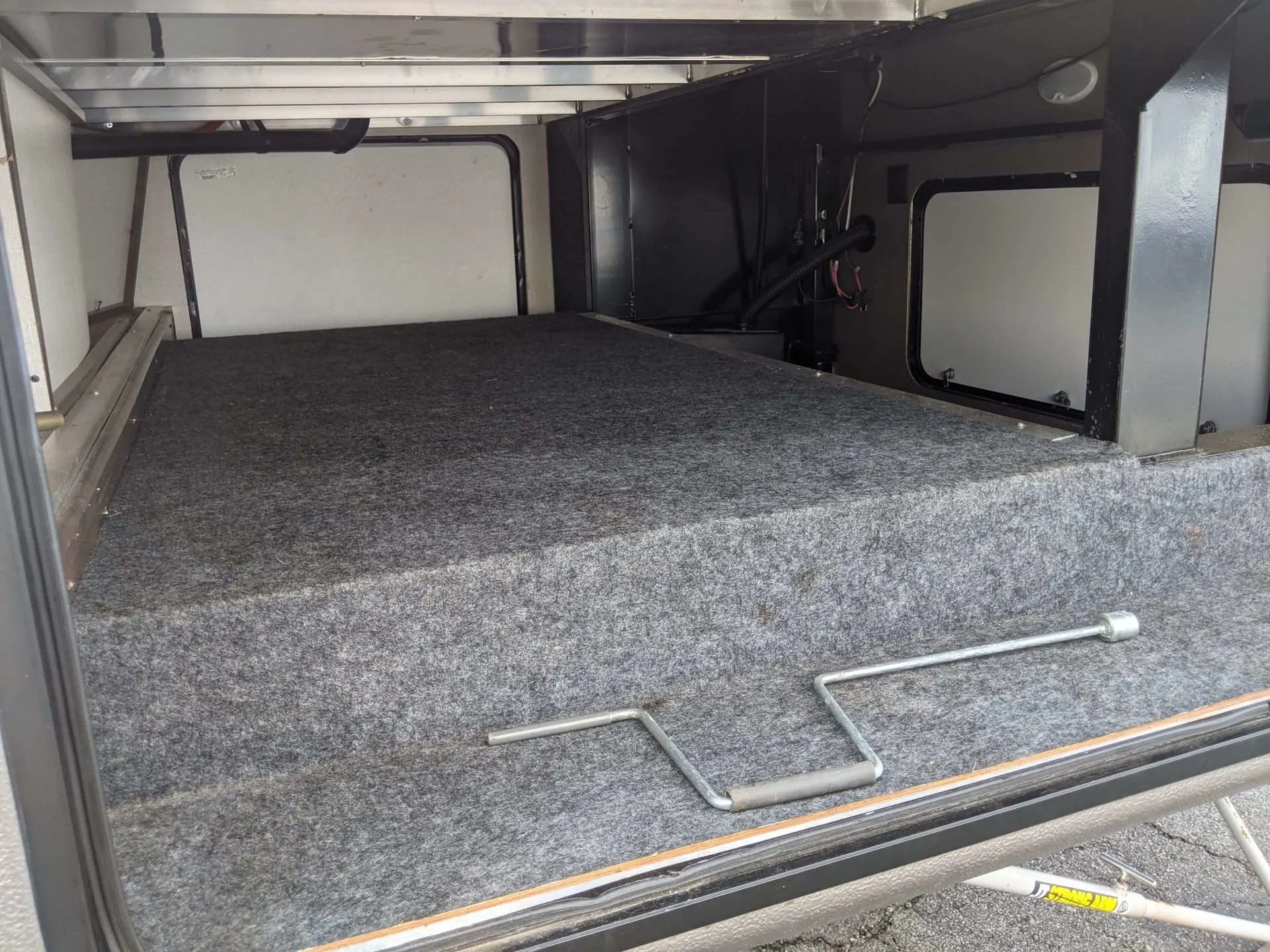
Usage:
Bulky Items: Suitable for storing bulky items such as generators, large containers, or spare tires.
Seasonal Gear: Can be used to store seasonal gear like winter coats, boots, or summer accessories.
Extra Supplies: Great space for extra supplies like bottled water, propane tanks, or firewood.
Organizational Tips:
Storage Bins: Use storage bins to keep smaller items organized.
Wall-Mounted Racks: Install wall-mounted racks for storing tools or other equipment.
Tips to Optimize these Storage Spaces
Inventory List: Maintain an inventory list to keep track of what’s stored where.
Weight Distribution: Ensure even weight distribution to maintain the stability of the trailer.
Regular Clean-Up: Regularly clean up these areas to prevent clutter and to make finding items easier.
Security: Consider adding locks to secure valuable items stored in these spaces.
Remember, the ideal use of pass-through and basement storage spaces will depend on your specific needs and the items you plan to carry during your travels. Always ensure that the items are stored securely and are well-organized to facilitate easy access.
Travel Trailer Bunkhouse Campers Bunk Room, Master Bedroom, and Sofa Bed
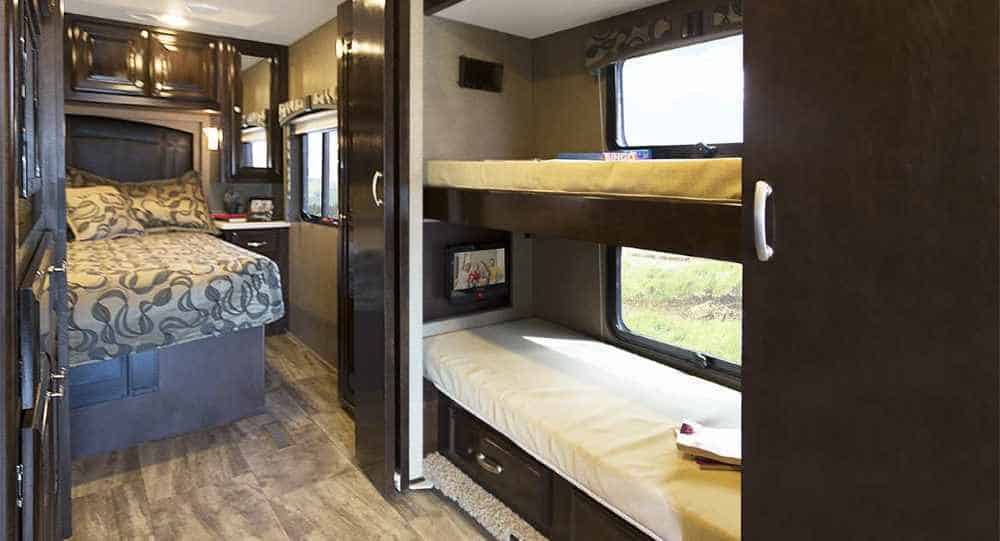
In travel trailer bunkhouse campers, the design and functionality of the bunk room, master bedroom, and sofa bed are critical components in ensuring comfort and a good night's sleep for all occupants. Let's explore these areas in detail:
Bunk Room
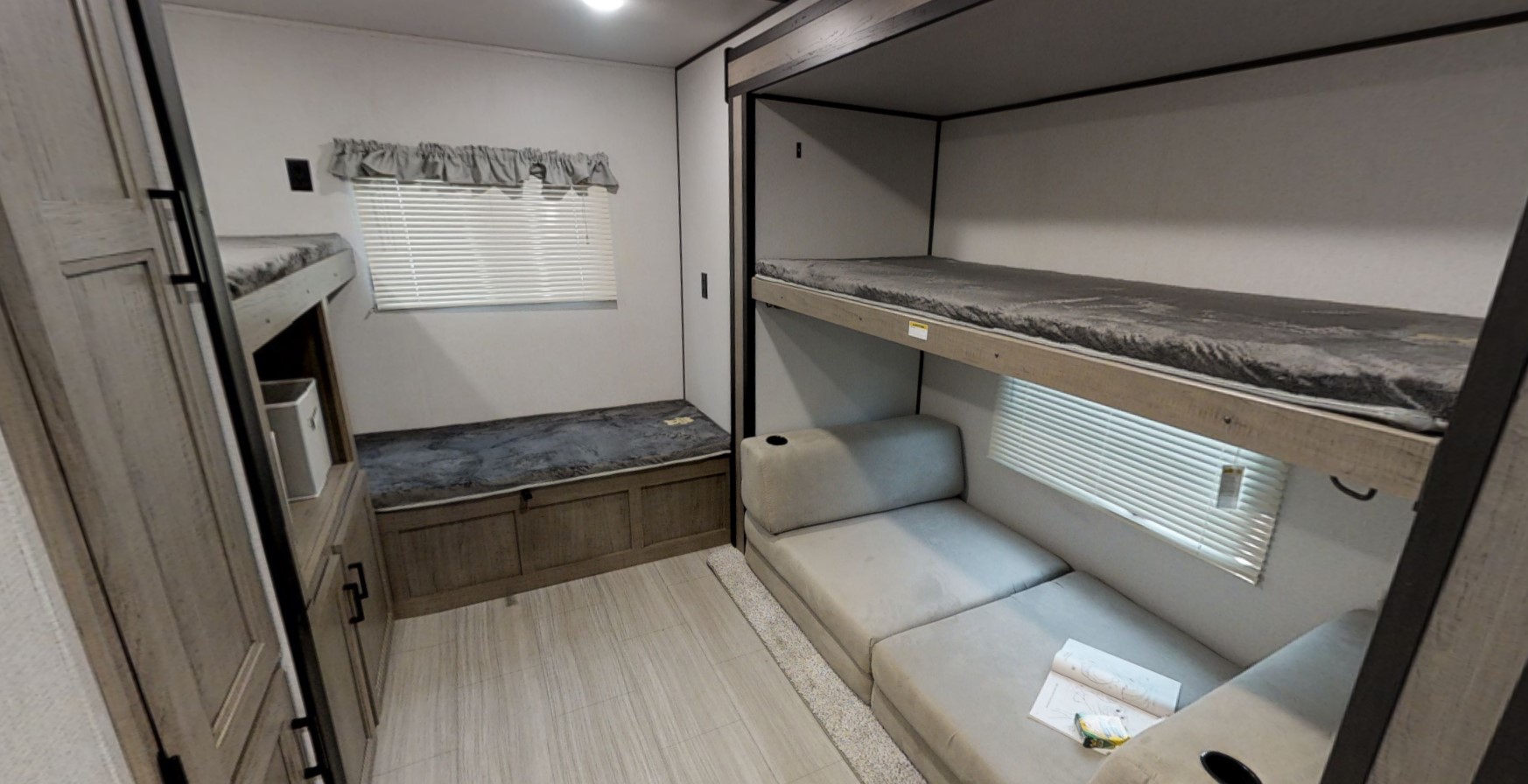
The bunk room is usually designed to maximize sleeping capacity, especially for children or additional guests. Here are some of its features and tips for utilizing this space:
Features
Multiple Bunks: These rooms can house multiple bunk beds, sometimes in a stacked or L-shaped configuration.
Storage: Bunk rooms often contain built-in storage solutions such as drawers or cabinets.
Privacy Curtains: Some bunk rooms come with privacy curtains to give occupants their private space.
Utilization Tips
Personalization: Allow individuals to personalize their bunks with their own bedding or decorations.
Organizational Accessories: Consider adding organizational accessories like pockets or nets for storing personal items.
Master Bedroom
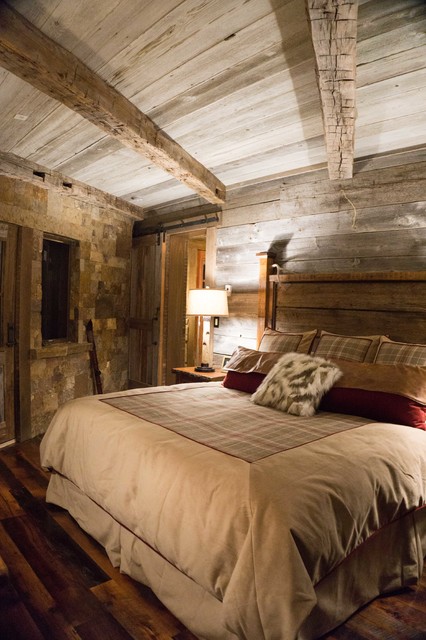
The master bedroom serves as the primary sleeping area for adults. It usually features a larger bed and more amenities compared to the bunk room.
Features
Queen or King Bed: Typically houses a queen or king-size bed with comfortable mattresses.
Wardrobe and Storage: Comes equipped with wardrobe closets, overhead cabinets, and sometimes under-bed storage.
Private Access: In some layouts, the master bedroom might have private access to the bathroom.
Utilization Tips
Bedding Storage: Utilize under-bed storage for extra bedding or seasonal clothing.
Personal Touch: Add personal touches with decorative items, quality bedding, and soft lighting to make the space cozy.
Sofa Bed
Sofa beds serve a dual purpose, functioning as a seating area during the day and converting to a bed at night.
Features
Easy Conversion: Designed for easy conversion from sofa to bed and vice versa.
Space-Saving: Serves as a space-saving solution, especially in smaller trailers.
Comfortable: When designed well, it offers a comfortable sleeping area without taking up much space.
Utilization Tips
Quality Bedding: Invest in quality bedding that can be easily stored during the day.
Dual-Purpose Accessories: Consider adding dual-purpose accessories like a coffee table that can double as a storage unit.
General Tips for Enhancing Comfort and Functionality
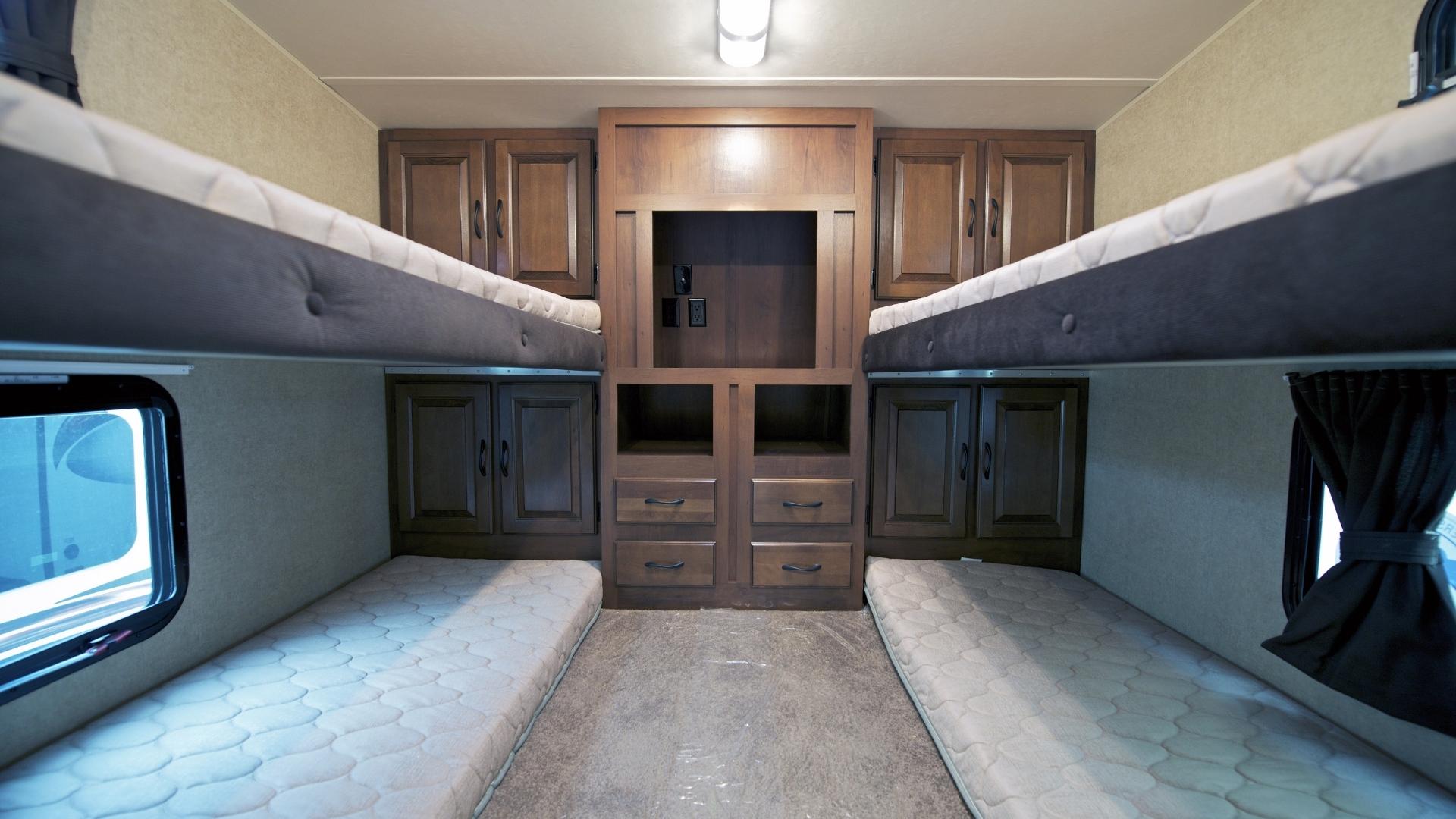
Ventilation: Ensure adequate ventilation in sleeping areas to keep the spaces fresh and comfortable.
Lighting: Incorporate proper lighting in each area, including reading lights in the bunk room and master bedroom.
Privacy: Install curtains or blinds to provide privacy in the master bedroom and bunk room.
Space Utilization: Utilize available space wisely by incorporating storage solutions that do not encroach on sleeping areas.
Personal Spaces: Create personal spaces in bunk rooms by allowing occupants to decorate or personalize their bunks.
By paying attention to the details in the design and utilization of the bunk room, master bedroom, and sofa bed, you can enhance the comfort and functionality of your travel trailer bunkhouse camper, making every trip a pleasant experience.
Travel Trailer Bunkhouse RV Convertible Dinette and Loft Area
In many bunkhouse RVs and travel trailers, convertible dinettes and loft areas are crucial elements that offer additional sleeping and storage spaces, without compromising on the overall comfort and functionality of the RV. Let's delve into these two components:
Convertible Dinette
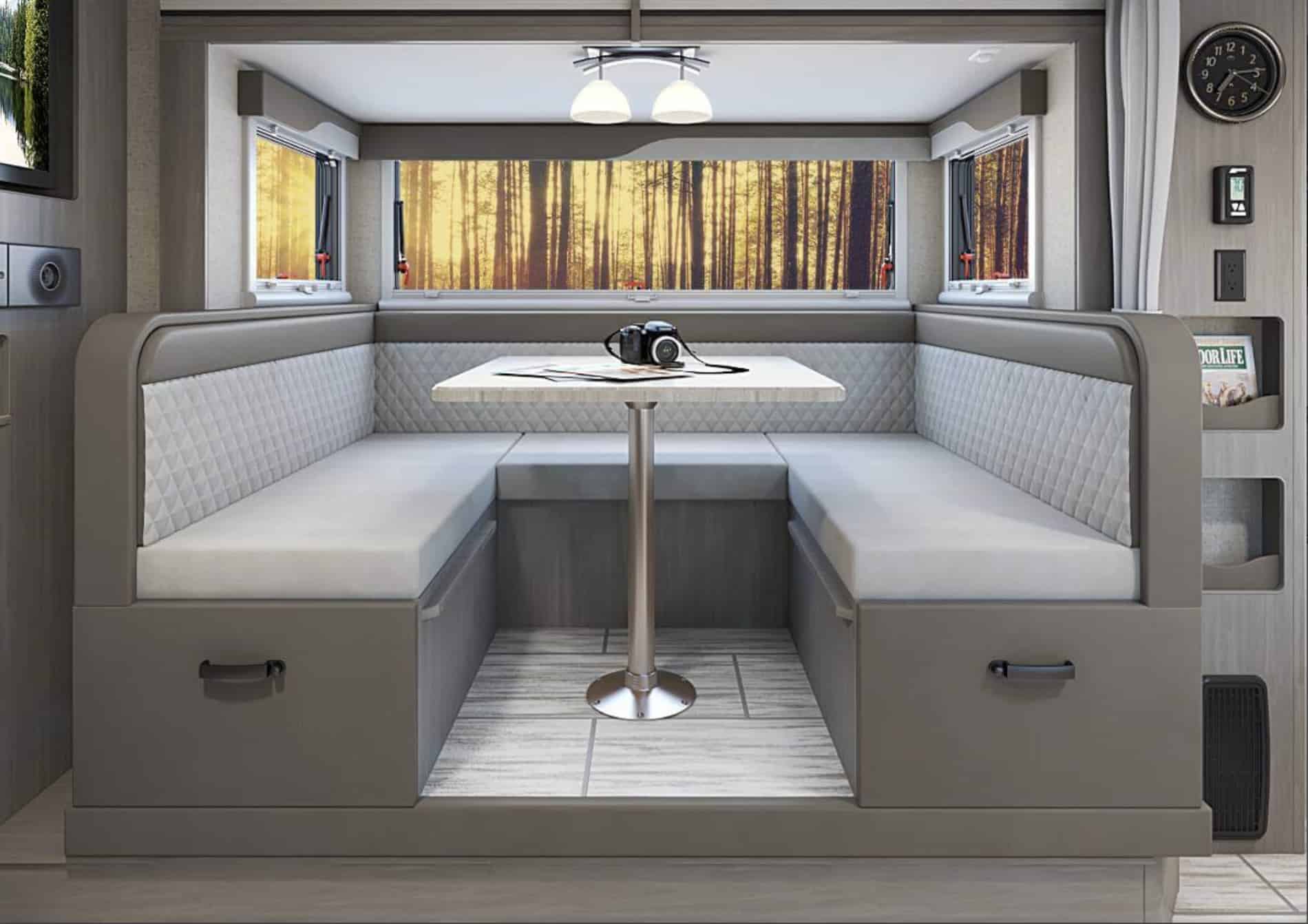
A convertible dinette serves as a multi-purpose area where occupants can eat, work, and convert it to a sleeping space as needed. Here are its features and tips for utilization:
Features
Dual-Function Furniture: The furniture in this area can easily be transformed from a dining area to a bed.
Space-Saving Design: Designed to optimize space utilization in the RV.
Storage Compartments: Often features built-in storage compartments beneath the seats for additional storage space.
Utilization Tips
Easy Conversion: Ensure the conversion process from dinette to bed is simple and hassle-free.
Comfortable Bedding: Keep comfortable bedding handy that can be easily laid out when the dinette is converted to a bed.
Organized Storage: Utilize the under-seat storage to keep necessary items organized and easily accessible.
Loft Area
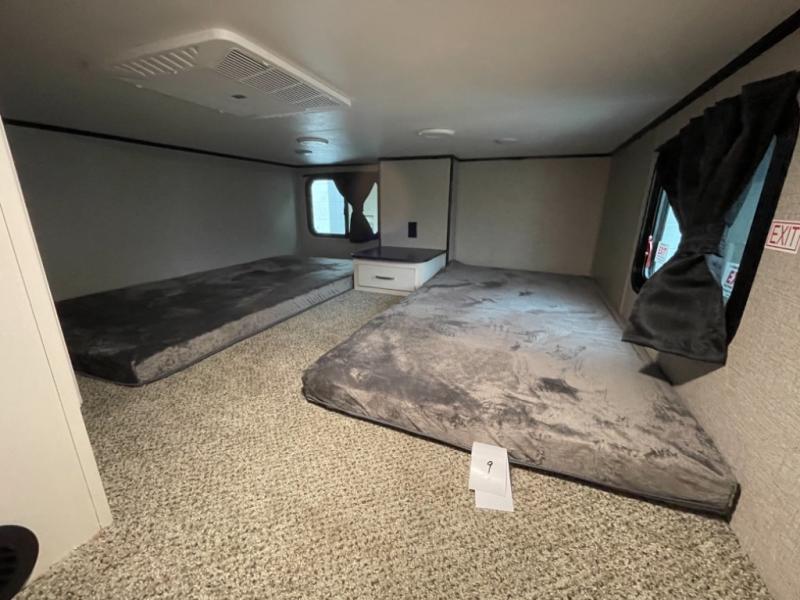
The loft area usually utilizes the vertical space in the RV, offering a cozy, elevated space for sleeping or relaxation. Here are the features and usage tips for this area:
Features
Elevated Sleeping Space: Offers a tucked-away, elevated and extra sleeping space, often located above the living area or the master bedroom.
Safety Measures: Equipped with safety measures like railings to prevent falls.
Access Ladder: Usually accessible by a ladder or a set of stairs for easy reach.
Ventilation and Lighting: Often features windows or vents for natural light and ventilation.
Utilization Tips
Cozy Bedding: Equip the loft with cozy bedding to create a comfortable sleeping environment.
Personalization: Allow individuals to personalize the loft area with decorations, personal items, or reading lights.
Safety Precautions: Ensure that safety precautions, like sturdy railings, are in place to prevent accidents, especially if children are using the space.
Loft Curtains: Consider adding curtains to the loft area for added privacy.
Additional Tips to Enhance Comfort and Functionality
Versatile Furniture: Invest in versatile furniture that can serve multiple purposes, such as a dinette that converts into a bed or a storage unit.
Optimized Space: Utilize space smartly by incorporating storage solutions that use up unused corners or underutilized spaces.
Lighting: Make sure that both areas have sufficient lighting to create a warm and welcoming environment.
Ventilation: Ensure that both spaces are well-ventilated to prevent stuffiness and maintain a fresh atmosphere.
Safety First: In the loft area, prioritize safety, especially if it is being used by children, by installing safety gates or railings as needed.
By considering these features and utilization tips, you can enhance the comfort and functionality of the convertible dinette and loft area in your travel trailer bunkhouse RV, making every trip a memorable and comfortable experience.
General Tips for Enhancing Comfort and Functionality in your Travel Trailer Bunkhouse Models
Enhancing comfort and functionality in a travel trailer bunkhouse or your recreational vehicle involves a blend of smart space utilization, personalized décor, and added amenities for a comfortable living experience. Here are some general tips that can be applied to various aspects of your bunkhouse trailer or luxury travel trailers to make it more homely and functional, also remember to look at the floor plan:
1. Space Optimization:
Foldable Furniture: Use foldable furniture that can be stowed away when not in use to create more space.
Wall-Mounted Facilities: Use wall-mounted tables, fold-down desks, or retractable counters to save floor space.
Corner Shelves: Install corner shelves to utilize unused spaces efficiently.
2. Storage Solutions:
Storage Bins: Use storage bins and organizers in cabinets and under beds to keep things tidy.
Hanging Storage: Implement hanging storage solutions like over-the-door organizers for additional space.
Hidden Storage: Create hidden storage spaces in furniture or under the flooring for items that are not frequently used.
3. Comfort Enhancements:
Quality Bedding: Invest in quality bedding and mattresses to ensure a comfortable sleep.
Climate Control: Ensure proper insulation and climate control features to maintain a comfortable temperature inside.
Lighting: Install adjustable lighting to create a cozy atmosphere in different areas of the trailer.
4. Personalization:
Décor: Add personal touches with decorative items, pictures, or artworks that reflect your style.
Plants: Incorporate indoor plants to bring a touch of nature inside and enhance the living space.
Textiles: Use textiles like rugs, curtains, and cushions to add warmth and personality to the space.
5. Functional Kitchen:
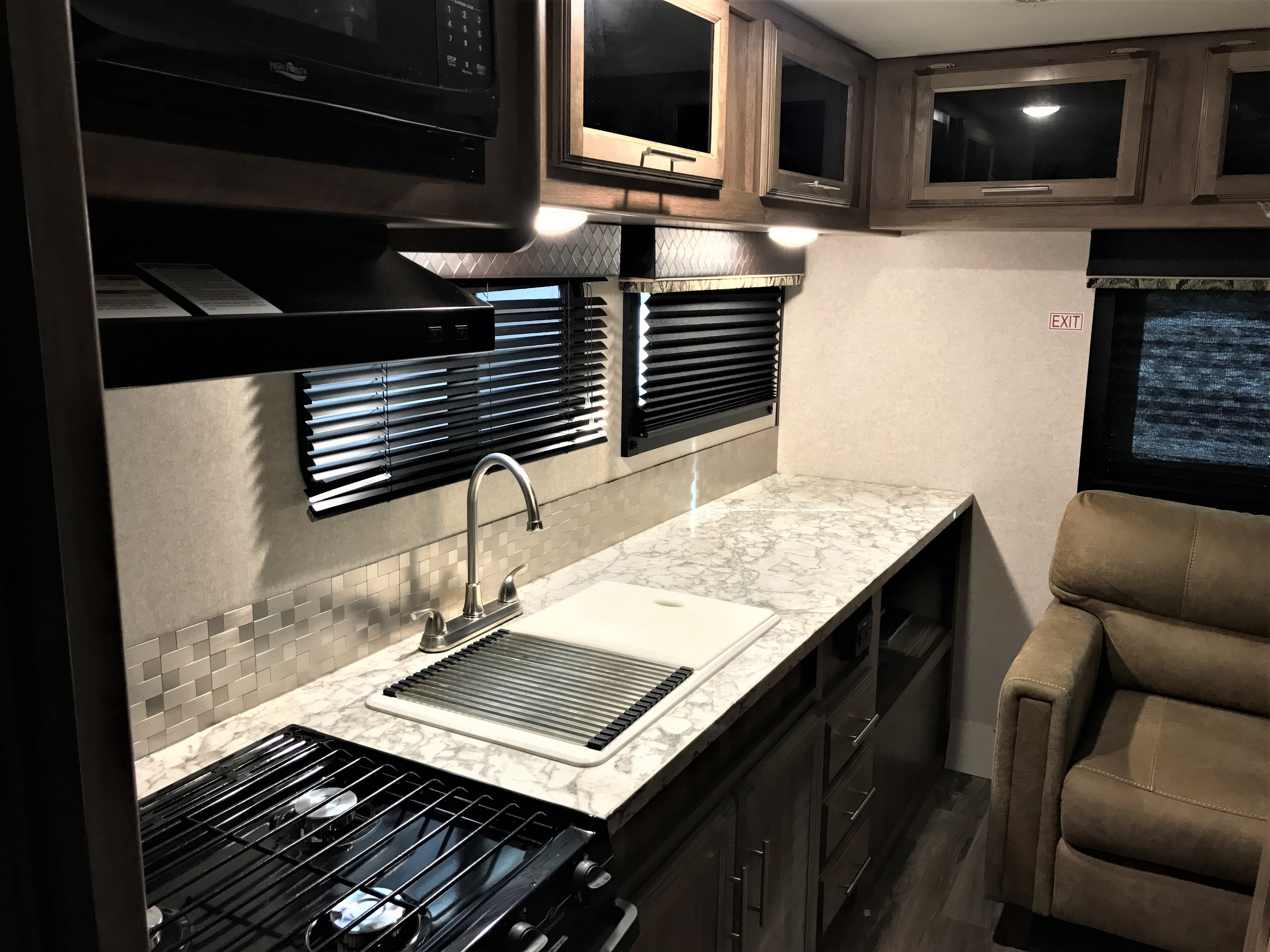
Appliance Selection: Choose appliances that are compact yet functional to save space and make cooking easier.
Modular Storage: Implement modular storage solutions in the kitchen to keep utensils and ingredients organized.
Multipurpose Kitchenware: Use multipurpose kitchenware to reduce the number of items needed and save storage space.
6. Entertainment Facilities:
Multi-Functional Entertainment Center: Have a multi-functional entertainment center that can house books, games, and electronics.
Outdoor Setup: Create an outdoor entertainment setup with foldable furniture, a portable grill, and a retractable awning.
7. Safety Measures:
Safety Equipment: Equip the trailer with necessary safety equipment like smoke detectors, carbon monoxide detectors, and fire extinguishers.
Child Safety: If traveling with children, ensure child safety features like safety gates and window guards are in place.
8. Technology Integration:
Smart Systems: Integrate smart systems for lighting, climate control, and security for a modern and convenient living experience.
WiFi and Connectivity: Ensure good WiFi connectivity and charging stations to keep devices charged and stay connected.
9. Outdoor Living:
Outdoor Storage: Equip the exterior with ample storage solutions for outdoor equipment and tools.
Outdoor Shower: Consider installing an outdoor shower for convenience, especially after a day at the beach or hiking.
Remember, enhancing comfort and functionality in your travel trailer bunkhouse is about balancing efficient space utilization with personal preferences to create a living space that feels like home while on the road.


